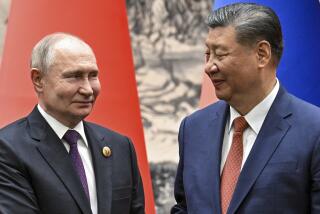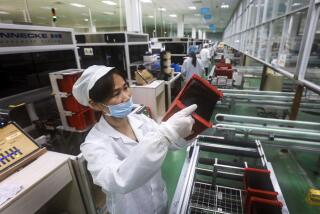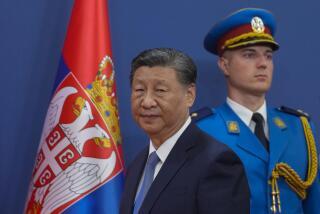China hopes to placate Trump with promise to buy billions more in U.S. goods
Reporting from Washington — Chinese officials are hoping to mollify President Trump’s oft-stated displeasure with America’s huge trade imbalance with China by pledging to import “at least $200 billion” more in made-in-the-USA products, the director of the White House National Economic Council said Friday.
Larry Kudlow, the president’s chief economic advisor, said that meetings Thursday and Friday with Chinese trade officials went well and that President Trump was more optimistic “than I’ve seen him” that a deal can be reached to avert a global trade war.
“China’s come to trade,” Kudlow told reporters Friday. “They are meeting many of our demands. There’s no deal yet to be sure. It’s probably going to take a while. It’s a process. But they’re coming to play. I believe they want to make a deal.”
Analysts doubted, however, that China will be able to boost imports fast enough or in the amounts needed to meet earlier demands by Trump to shave more than half of the $370-billion merchandise trade surplus with the United States by 2020.
More important, analysts warn, such purchases would do little to address systemic problems in the trading relationship and American grievances involving China’s aggressive industrial policies. Many U.S. businesses have complained about China’s theft of intellectual property and forced technology transfers to do business there.
Senate Minority Leader Charles E. Schumer (D-N.Y.) urged Trump to reject the offer. “Don’t let President Xi play you,” Schumer wrote in a tweet Friday. “Trading some short-term purchases of American goods and giving up on China’s theft of American intellectual property (which are our family jewels that will create millions of good paying jobs) is the art of a bad deal.”
Kudlow stressed that such issues were still on the table. “I think just as important, they have to lower their tariff rates, they have to lower their non-tariff barriers,” he said. “We have to have a verifiable process whereby the technology transfers and the theft of intellectual property stops.”
Also, some Chinese officials cast doubt on the $200-billion offer. According to Bloomberg on Friday, a Chinese Foreign Ministry official said he was unaware of such an agreement.
Still, American business groups with interests in China were encouraged by the continuing dialogue and noted that the latest visit by the Beijing delegation, led by Vice Premier Liu He, marked a sharp contrast to Liu’s previous meeting in Washington in February, when the high-level emissary was practically snubbed by Trump. The president announced tariffs targeting Chinese steel on the day Liu was holding talks with administration officials.
On Thursday, Trump received Liu in the Oval Office and tweeted a photo of the two men shaking hands.
Just two weeks ago, Treasury Secretary Steven T. Mnuchin, Commerce Secretary Wilbur Ross, U.S. Trade Representative Robert Lighthizer and other senior administration officials, in a visit to Beijing, came away empty after exchanging unusually tough demands with Liu and other Chinese officials.
“They were pretty far apart and [had] a wide gap to overcome, so I think it’s good that on a pretty quick basis that Vice Premier Liu comes here to continue discussions,” said John Frisbie, president of the U.S.-China Business Council, which represents some 200 large companies doing business in China, including General Motors, Walmart and FedEx.
He said he hoped for an “early harvest,” or some immediate outcomes, to emerge from the two days of talks that could defuse tensions and help lead both sides to step back from threats of massive tariffs that have stoked fears of a trade war between the two biggest economies in the world.
At the same time, Frisbie said, any short-term results should not come at the expense of dealing squarely with the structural issues in the relationship, such as market access and protection of intellectual property.
At the top of the Trump administration’s demands outlined two weeks ago was a $200-billion reduction in China’s trade surplus with the United States, reflecting the president’s perspective of the bilateral trade number as the key scorecard, even though economists widely view the U.S. trade deficit as caused largely by a mismatch between the nation’s savings and investments.
China’s response in committing to ramp up purchases of American goods was clearly aimed at soothing Trump’s personal sore point with China, but experts said it was hard to see how Beijing could make a big dent in the deficit anytime soon.
For one thing, China can buy only so many Boeing airplanes and soybeans, the top two U.S. imports in China. Beijing could direct Chinese firms to shift purchases from other countries to the U.S., but that would present problems for China’s relations with other nations and also risk putting too much dependence on America.
The Chinese proposal was said to include importing the United States’ growing production of energy resources such as natural gas, but a lack of pipeline and other U.S. infrastructure constraints would limit such purchases in the near term.
For years Chinese officials have argued that the U.S. could improve its trade balance with China by relaxing export controls prohibiting the sale of various U.S. software, equipment and other products that could contribute to the Asian country’s military capabilities.
But the recent trend has been to tighten these controls, not ease them, the latest example being the recent ban on U.S. companies’ selling products to ZTE, the giant Chinese telecom-equipment maker. The Trump administration last month sanctioned ZTE for violating a previous settlement over illegal shipments to Iran, although the president this week indicated that those restrictions could be softened as a favor to Chinese President Xi Jinping.
Trump’s reversal of position on ZTE helped pave the way for the talks this week but also perpetuated confusion and questions about what Trump would be willing to accept and what would weigh in that decision.
As before, the president on Thursday referred to his special relationship with China’s Xi. At the same time, he criticized China and other U.S. trading partners as “very spoiled.” He also suggested China was behind North Korea’s recent second thoughts about attending a June summit with Trump as a way to increase China’s leverage in the U.S. trade talks.
Previously Trump had offered to ease up trade demands on China if Xi would help the U.S. rein in North Korea’s nuclear program.
“I’m at a loss as to understand what the administration’s priorities are with China,” said Wendy Cutler, who has led trade negotiations for Presidents George W. Bush and Obama and is now vice president of the Asia Society Policy Institute.
“They’ve put so many issues on the table, and it’s unclear to me whether they would be willing to settle for a deal if China agrees to buy more U.S. goods and lower the trade deficit,” she said. “Is that sufficient for a deal with some market access commitments, or do they need to see underlying structural changes? ... All of these issues were in their proposal, and they just don’t lend themselves to a quick deal.”
Sharp differences in the upper reaches of the Trump administration also have complicated matters. The U.S. side is being led by Mnuchin, who analysts say has been eager to seek a deal with China’s Liu and calm trade waters that have weighed on financial markets and the broader American economy. But other senior administration officials, Lighthizer and especially trade advisor Peter Navarro, have been more vocal critics of the Chinese and have preferred a more antagonistic approach.
Navarro, a former UC Irvine professor and noted China hawk, was said to have been excluded from the two-day meetings with Liu and the Chinese delegation.
“The Chinese don’t want him in the room, and if the U.S. wants a deal, the U.S. doesn’t want him either,” said Derek Scissors, a China expert at the American Enterprise Institute.
Regardless of the rift or any immediate gains from the talks, Scissors said, the forces shaping the long-term competitive battle between the two countries will be much more difficult to find a middle ground on.
“Even if there’s a deal, it won’t change the trajectory of the U.S.-China story,” he said.
Twitter: @dleelatimes
Twitter: @noahbierman
UPDATES:
2:35 p.m.: This article was updated with Kudlow’s comments.
1:15 p.m.: This article was updated with Schumer’s tweet.
This article was originally published at 9 a.m.
More to Read
Inside the business of entertainment
The Wide Shot brings you news, analysis and insights on everything from streaming wars to production — and what it all means for the future.
You may occasionally receive promotional content from the Los Angeles Times.












